Ever wonder which links people click that take them away from your website? You can find out when you learn how to track outbound links in Google Analytics.
There are many reasons to use external or outbound links, like citing other sites as sources of information. By tracking which external links get the most clicks in Google Analytics, you can find out where your visitors are going after they’ve been on your website.
In this article, we’ll show you how to track outbound links in Google Analytics and how to find your GA4 outbound links report. Let’s get started…
- What Are Outbound Links?
- Set Up GA4 Outbound Link Tracking
- View Outbound Link Clicks in WordPress
- View Outbound Links in Google Analytics
What Are Outbound Links?
Outbound links, also called external links or outgoing links, are links on a web page that point to another website or domain. Outbound links are used to reference other sources, provide additional information, or direct users to related content on the internet. While internal links point users to other content on your own site and backlinks direct users to your site from an outside source, outbound links point visitors away from your website.
Why Track Outbound Links?
So, you might be wondering what the advantage of tracking outbound links is since people who click them are leaving your site. Well, there are actually a number of benefits to finding out which external links visitors click, such as:
- Get to Know Your Visitors Better – Seeing which links users click and where they go from your site helps you understand how visitors behave and interact with your content.
- Discover New Content Topics – Outbound link tracking can help you discover new content ideas. If a lot of people click on a link to read an article on another website, that’s an indicator that you should consider creating a similar blog post on your own site. That way, you can provide the information they’re looking for directly and keep them from leaving.
- Create Partnerships – When people click on an external link, it means you’re sending traffic to that website. You can form a partnership with these sites, like collaborating on content, submitting a guest post to get backlinks and improve SEO, or signing up for their affiliate link program to get extra revenue.
Can Google Analytics Track Outbound Links?
Yes, Google Analytics 4 can track outbound links, but it won’t show you external link reports by default. You’ll need to enable this feature and create a custom report to get data about which external links are getting the most clicks on your site, but there’s an easier way to see outbound traffic tracking reports! We’ll walk you through the best way to set up event tracking and access your outbound link report in only a few clicks.
So, are you ready to learn how to use Google Analytics to track outbound links?
How to Set Up GA4 Outbound Link Tracking
Google Analytics 4 (GA4) makes manually tracking outbound links a little less time-consuming than it was in the previous version (Universal Analytics), but it’s still not very beginner-friendly.
Setting up Google Analytics on your site can be a pain as it requires editing code. Plus, you’ll have to navigate Google Analytics to find the data you need about external links, which isn’t a quick task for non-professionals.
But what if there’s a much simpler way?
ExactMetrics is the best premium WordPress Analytics plugin, allowing you to easily set up Google Analytics without editing any code or needing a complicated tool like Google Tag Manager.
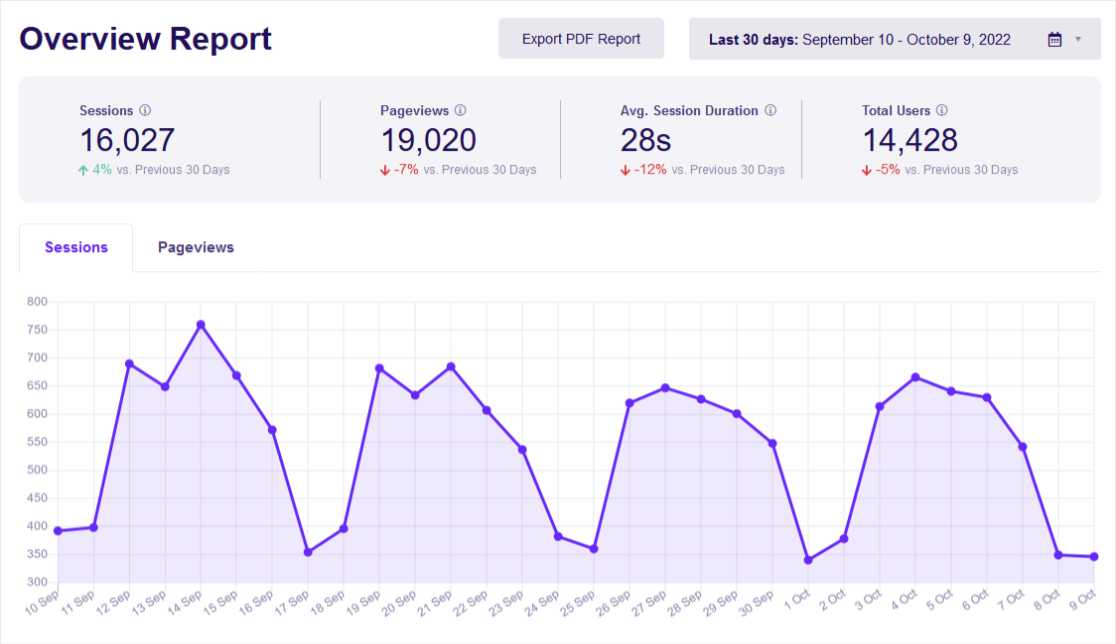
With ExactMetrics, you get outbound link tracking and other advanced tracking features right out of the box and Google Analytics reports right inside your WordPress dashboard.
Plus, you gain access to tons of additional Google Analytics features and advanced tracking capabilities with just a few simple clicks such as 1-click eCommerce tracking, affiliate link tracking, social media tracking, form conversion tracking, video play tracking, and lots more.
Using ExactMetrics, you can automatically track external link clicks and see your top outbound links report in WordPress. There’s no need to touch a single line of code, hire a developer, or set up tags with GTM. The plugin takes care of everything for you.
Just follow these steps to get started with the tutorial. Don’t have a WordPress site? Skip to our Google Analytics section.
Install and Activate ExactMetrics
The first step is to install the ExactMetrics plugin on your site. Do note that if you want to be able to see your top outbound links report right inside WordPress, you’ll need the Plus license or above.
Download the plugin’s ZIP file from your account area under the Downloads tab.
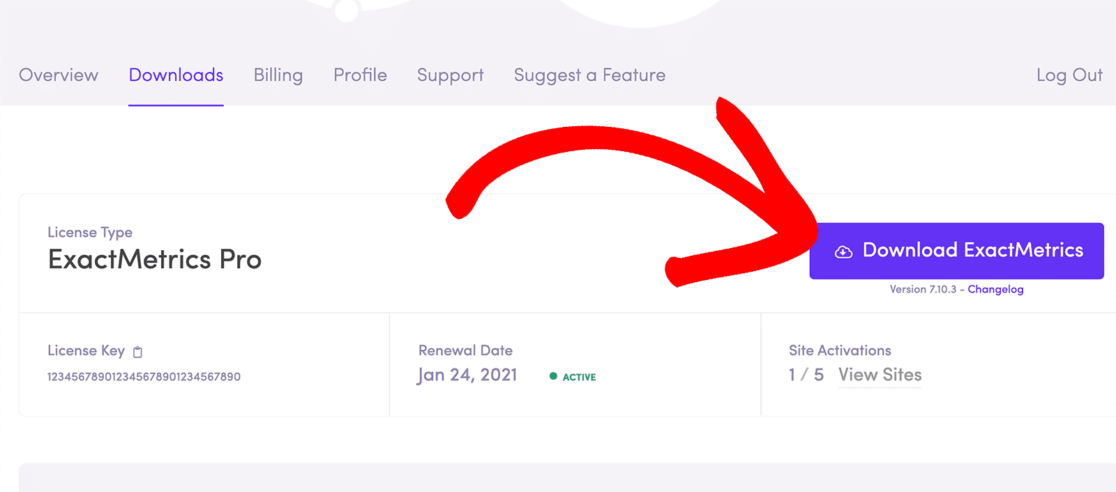
Next, go to your WordPress site and upload the plugin. Make sure to press Activate after the ZIP file finishes installing.
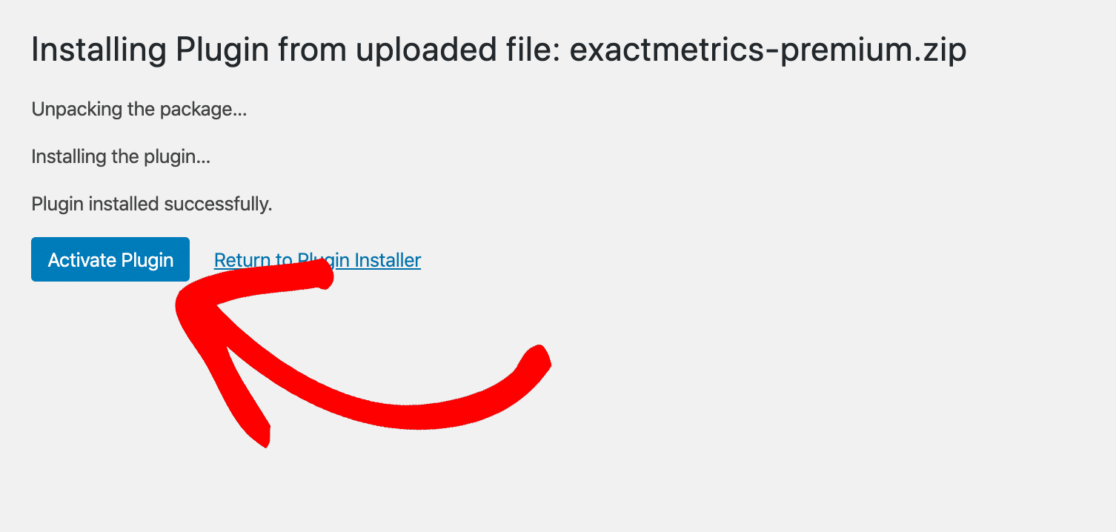
With the plugin installed, you can track how people interact and behave on your website. Aside from tracking outbound links, the plugin also shows you which files get the most downloads, which affiliate links get the most clicks, where your traffic is coming from, and much more.
You can use different features and addons to get even more insights about your visitors and improve your site. For instance, ExactMetrics can set up custom dimensions, track eCommerce store performance, and automate processes to ensure GDPR compliance.
Connect Google Analytics to Your WordPress Site
After ExactMetrics is up and running on your site, the next step is to connect Google Analytics to the plugin.
ExactMetrics offers a handy setup wizard that lets you add Google Analytics tracking to your website without editing code. Just follow the steps in the wizard to connect ExactMetrics to your Google Analytics account.
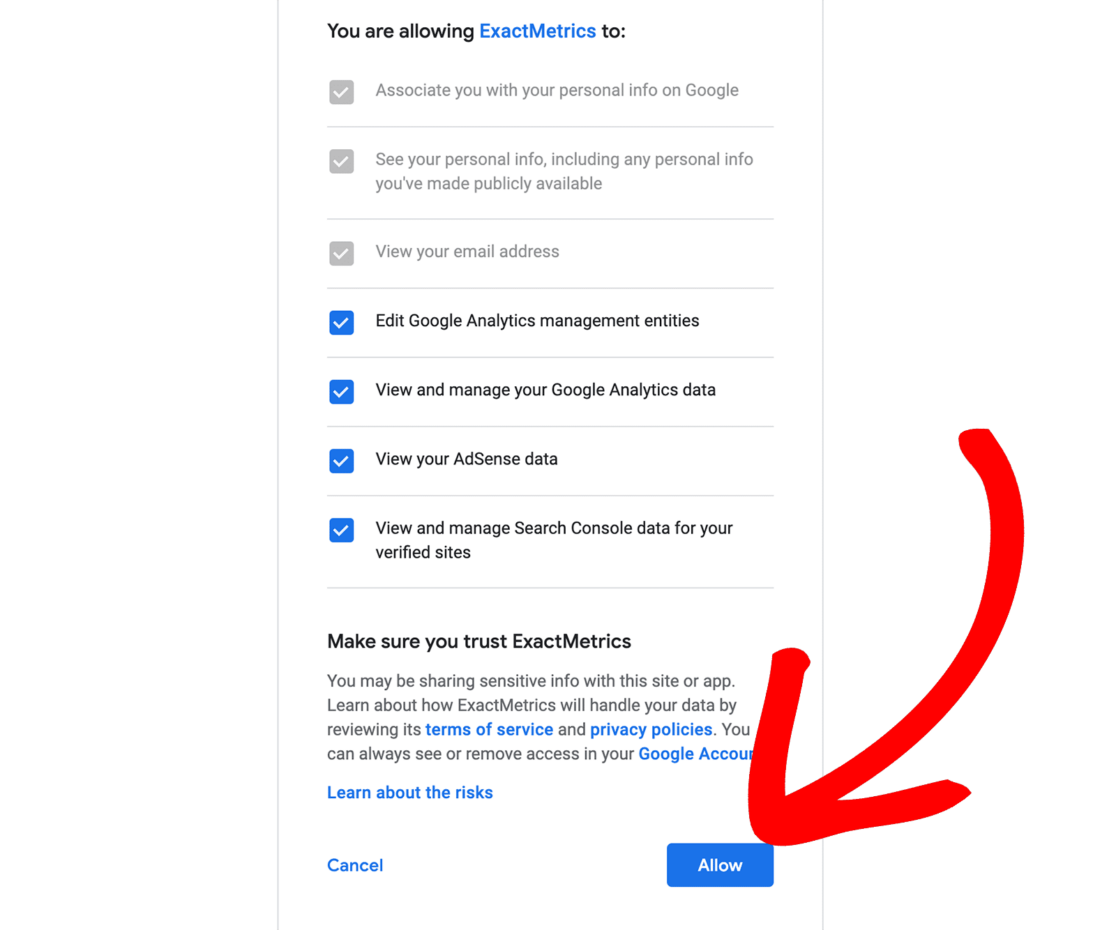
By the end of the setup process, the plugin will have automatically added the necessary tracking code to your site and configured everything behind the scenes. You can follow our guide on How to Add Google Analytics to WordPress for step-by-step instructions on getting set up.
How to View Outbound Link Clicks in WordPress
Next, you can view your outbound links report inside your WordPress dashboard. That’s one of the biggest advantages of using ExactMetrics. It brings all your important stats to one place, and you don’t even have to leave your site.
Remember, you’ll need ExactMetrics Plus or a higher plan to see your outbound link clicks.
To view the report, go to your WordPress dashboard and navigate to ExactMetrics » Reports. Click Publishers » Overview from the top menu. Now, scroll down to the Top Outbound Links report to see which external links people click the most.
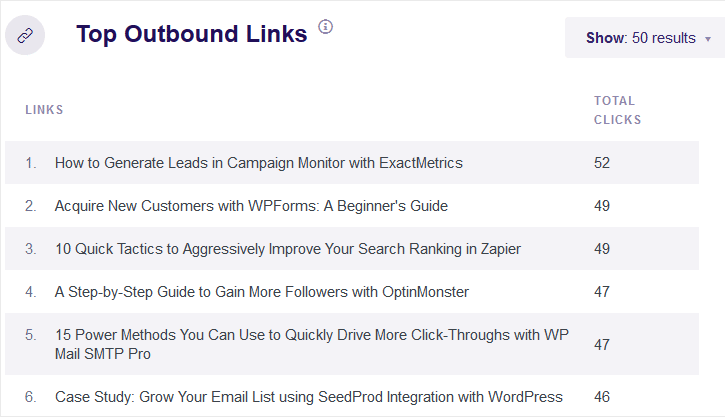
With ExactMetrics, you can easily see how many clicks your outbound links are getting. The report will show you up to 50 of your external links, but what if you want to see outbound link clicks in Google Analytics and uncover more data?
How to View Outbound Links in Google Analytics
ExactMetrics helps save time by showing your reports in WordPress, but if you want to view outbound links in Google Analytics and get more insights, we’ll show you how.
If you’re not using ExactMetrics, you’ll need to first make sure that you’ve enabled GA4 outbound link click tracking. To do this, Go to Admin » Data Streams, click your website stream, and toggle on Enhanced Measurement. Click the setting cog to customize tracking and make sure that Outbound clicks is turned on.
ExactMetrics users should NOT have Enhanced Measurement enabled as it can cause inaccurate reporting.
Now, to see the number of clicks on your outbound links and which pages those external links are on, we’ll build a custom report in GA4. To start, click the Explorations tab after logging into your Google Analytics account and select a new Blank report.
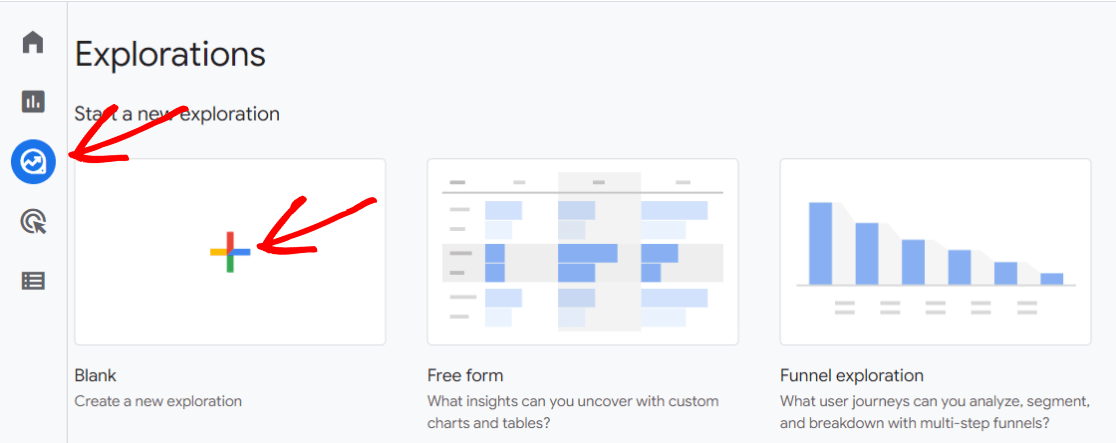
Go ahead and name your report, such as Outbound Link Clicks. Then, click the + sign next to where it says Dimensions in the first column.
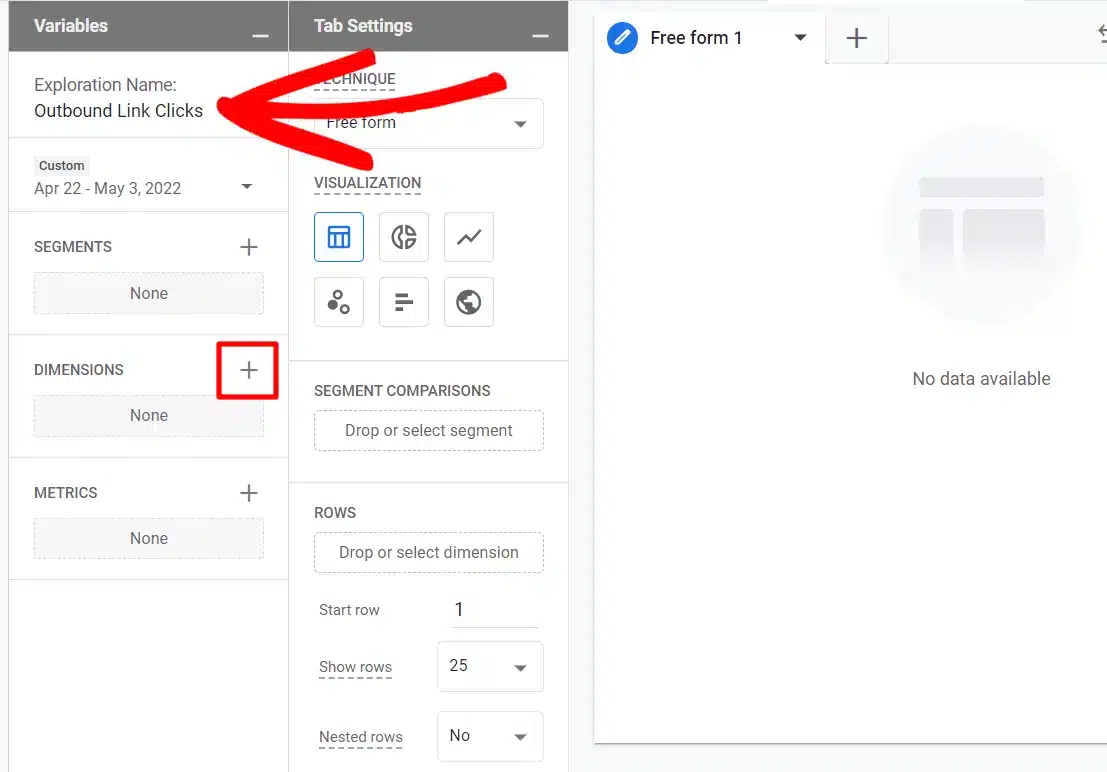
Now, an overlay screen will appear where you can select dimensions. Search for and check the box next to the following 4 dimensions:
- Event name
- Link text
- Outbound
- Page title
When you’ve finished clicking the boxes next to all 4 dimensions, press the blue Import button in the top right.
Then, click the the + sign next to Metrics in the first column of your report. Just like you did for dimensions, search for Event Name and check the box to select it. Press Import again.

Now, drag the Link Text and Page title dimensions from the first column to the second column, under Rows.
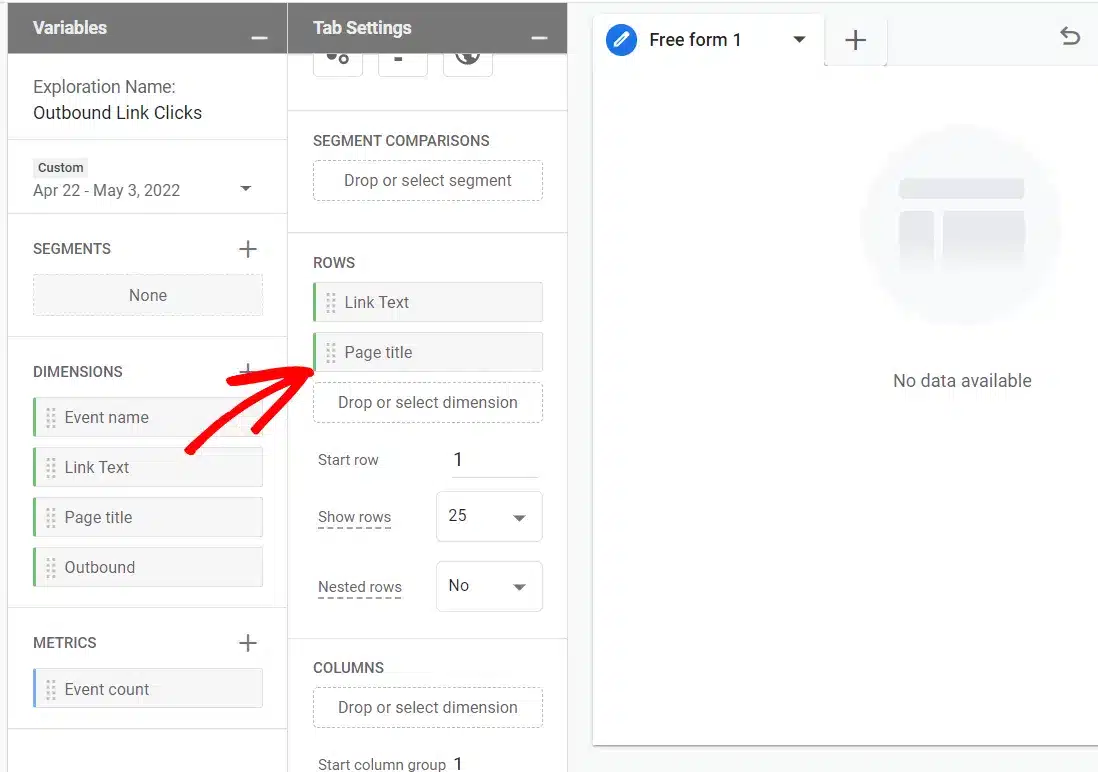
After that, do the same thing and drag Event count from the Metrics box on the left and place it under Values in the right column.
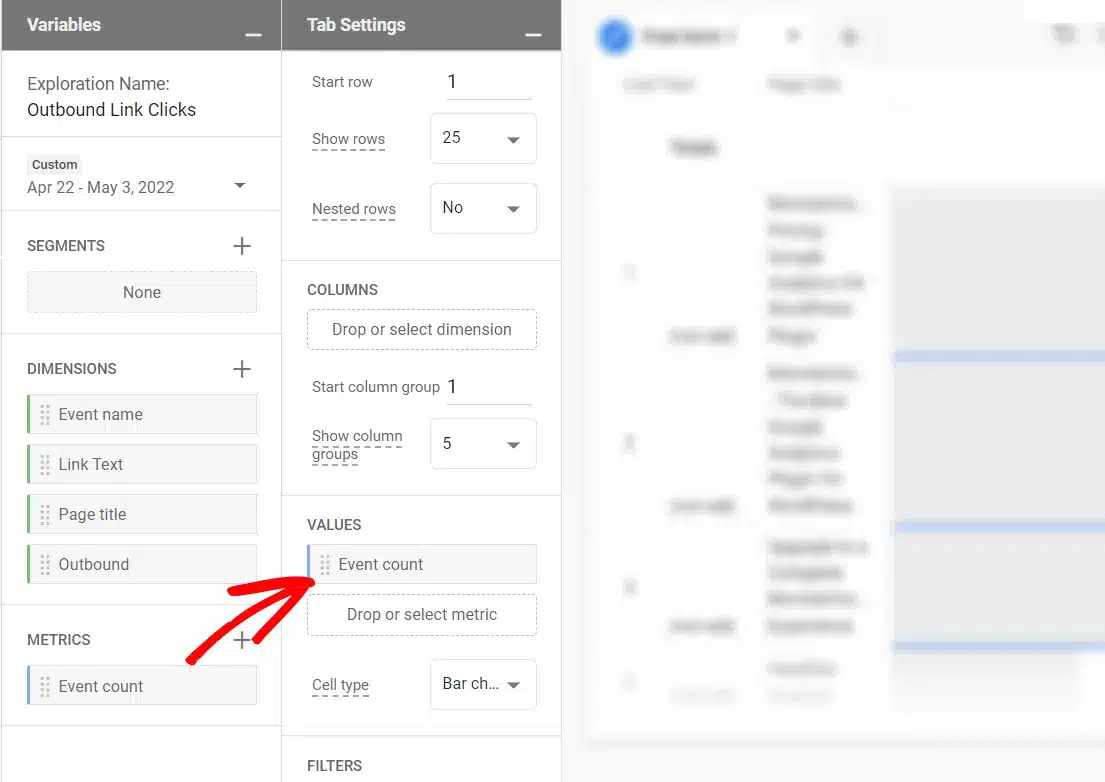
Next, drag the Event name dimension and place it under Filters. It will ask you to specify the details. Select exactly matches, type click on the next line. Press Apply.
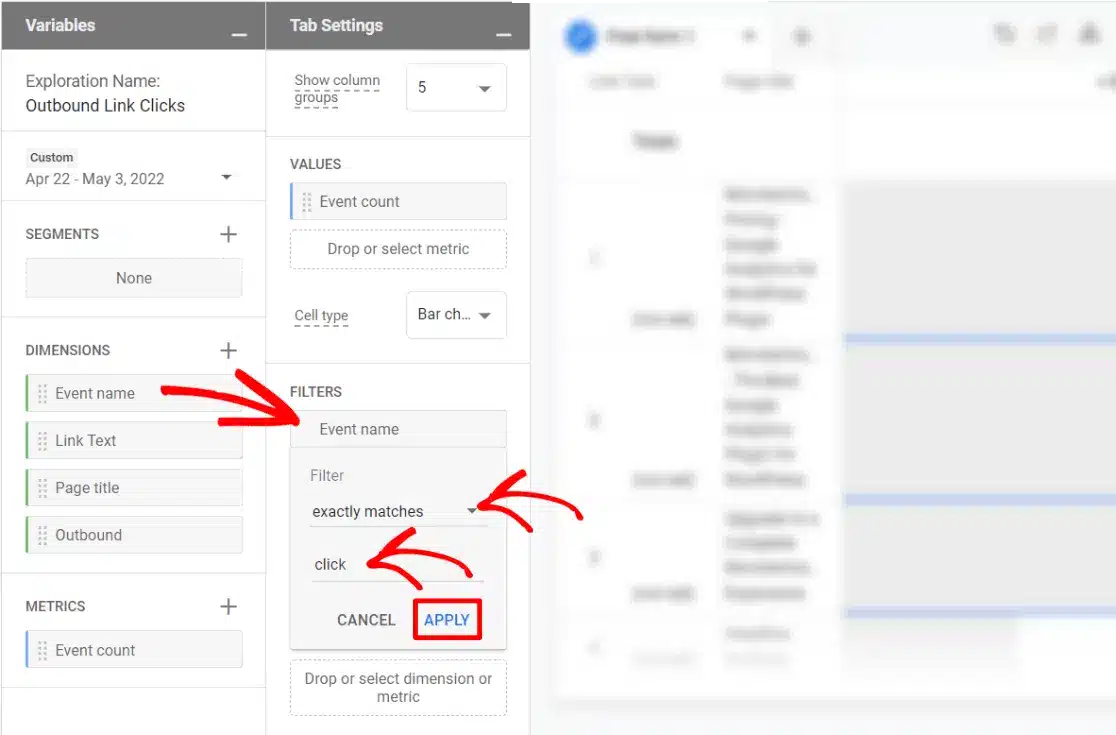
Lastly, drag Outbound from dimensions under the Filters area, and choose exactly matches. Select true, and hit Apply when you’re done.
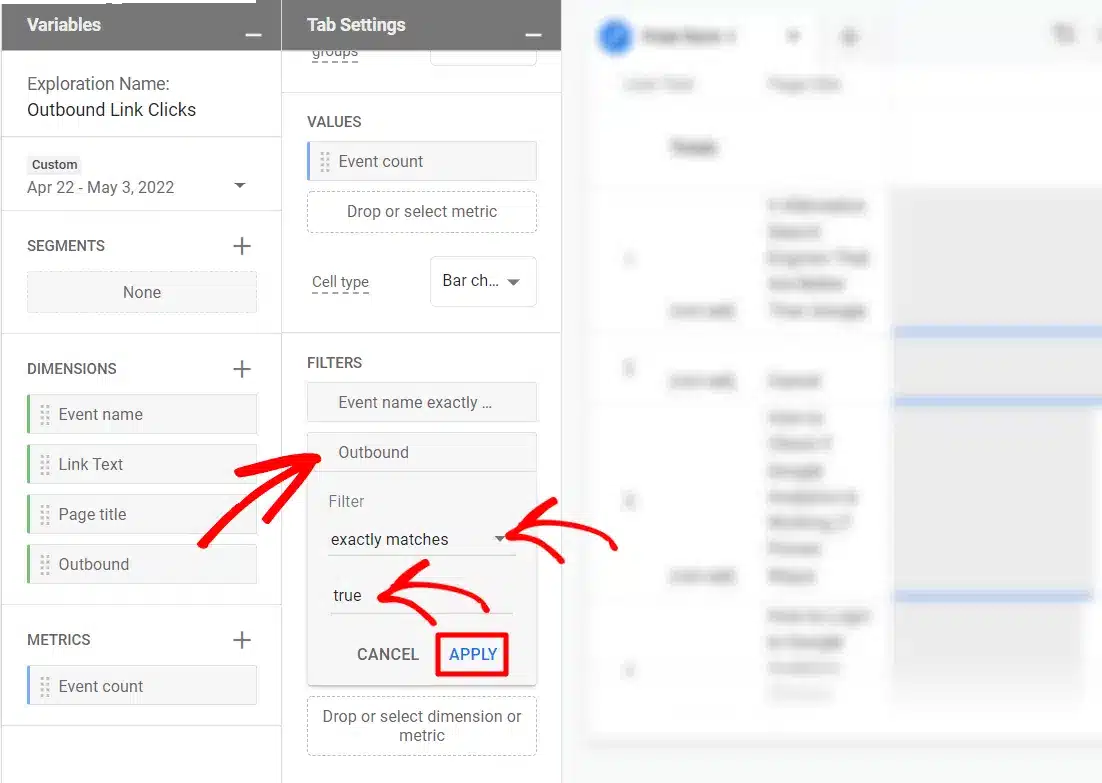
You’re done! You now have a custom report to track outbound links in Google Analytics 4. It shows you which pages those external links are on and the number of clicks for each.
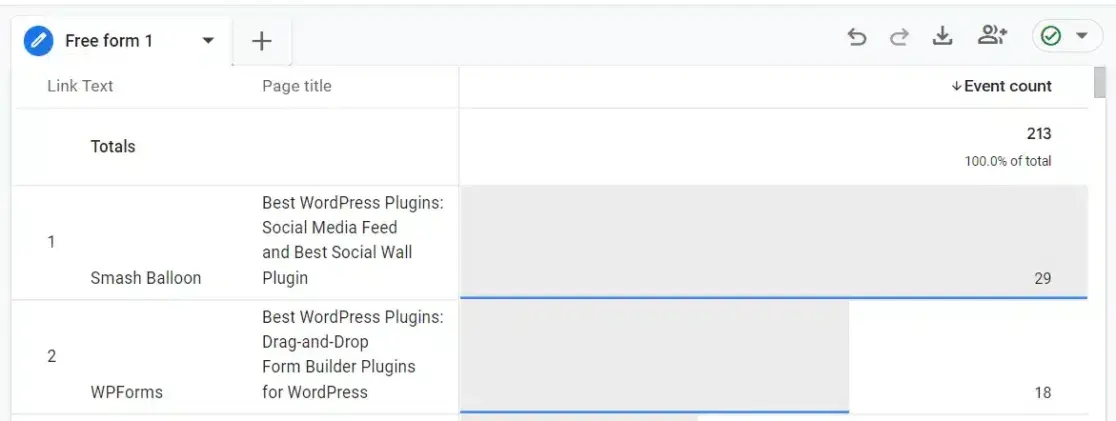
You can get more insights by adding other dimensions to your custom outbound link report. For instance, search and import Session default channel group in the dimensions and drag it to the columns row to see the traffic medium that visitors came from before clicking an outbound link.
Or, you could look at which device or browser people use when clicking the external links on your website.
And that’s it!
You can now easily track the number of clicks each outbound link gets without entering a code or manually setting up tracking.
We hope you liked our article on how to track outbound links in Google Analytics. You can also check out our post on Simple Ways to Grow Your Business with Google Analytics.
Not using ExactMetrics yet? What are you waiting for?
Don’t forget to follow us on Twitter and Facebook to see all the latest reviews, tips, and Google Analytics tutorials.

